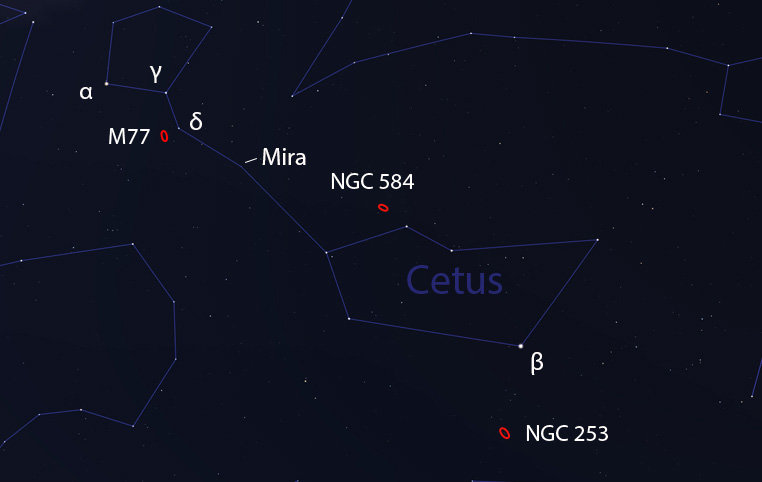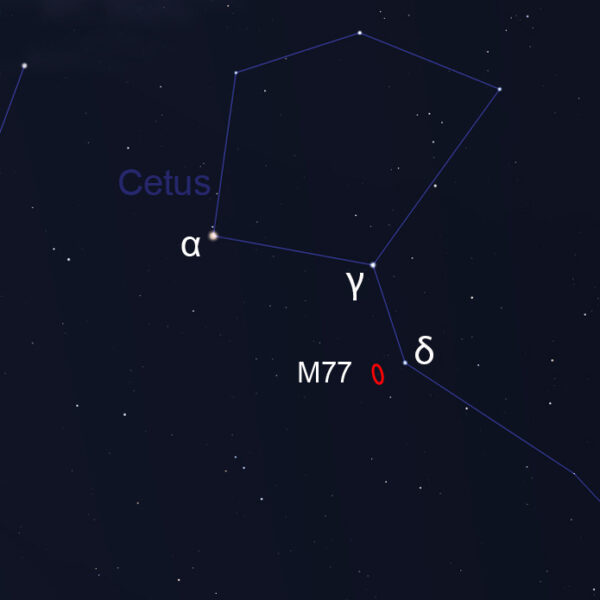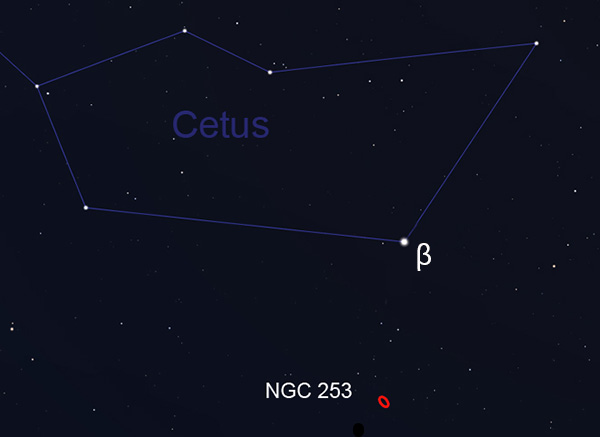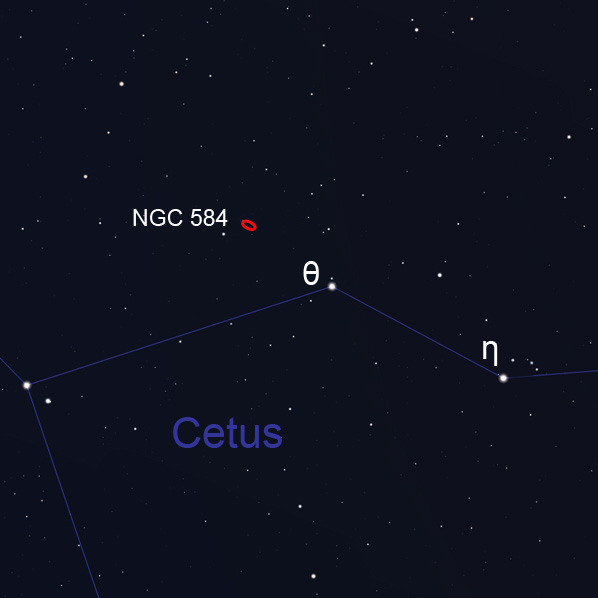Small telescopes can reel in some big ones in Cetus, the Whale.
Cetus, the Whale, swims after dark these late autumn nights, offering galaxies within range of a small scope. Let’s cast a line to see what we can catch!

Stellarium, with additions by author
For this excursion, we don’t need a big rig; a simple “rod ‘n reel” — a 4-inch refractor (f/7 in my case) will do. Intrepid anglers are encouraged to try with less. Successful observations hinge on practice and patience, not just gear. Dark skies do make a difference with galaxies, though, and a moonless night is recommended.
To switch to “galaxy” mode, head over to the magnificent Andromeda Galaxy (M31) and her two handmaidens, M32 and M110. While M32 jumps out in my 102-mm refractor, M110 is a bit more shy. Look for a smudge on the other side of Andromeda. After spotting its ghostly glow and setting expectations towards the faint, it’s time to go fishin’.
Bearing Check
The autumn seas we sail are dim and sometimes difficult to navigate. Spend a moment tracing the outline of Cetus.
Mira, one of the most famous variable stars in the sky, can play a prominent role in the outline of the constellation, but winks out of view at minima. It’s a fine target in its own right, and if the constellation looks different from your chart, this could be why.
“Squid Eye” Galaxy
Messier 77 is our first target, and I’ve nicknamed it the “Squid Eye Galaxy.” Aim a half degree (full-Moon diameter) southeast of Delta (δ) Ceti. Telrad users, put the middle ring on Delta, and nudge to the left. Keep an eye out for a misty “star,” as the galaxy’s core is surprisingly bright. The galaxy itself presents as something decidedly nonstellar as you sweep across the field.

Stellarium, with additions by author
Although it has a small apparent size, it’s one of the largest Messier galaxies and the closest active galaxy of type Seyfert II. Close is a relative term, though. M77 is 47 million light-years distant (compared to Andromeda’s 2.5 million).
This celestial “eye” peers back across space and time, burning with energetic activity. At its center is a supermassive black hole, spewing clouds of gas. The galaxy zooms away from us at 1,400 km/s (3 million mph); this “tiny” patch of mist tugs hard at the line.
Once you hook it, spend some time reeling it in. Glance at it with averted vision. Breathe deeply, too: The extra oxygen might help you see just a notch better.
Deep Dive Treasure
NGC 253 (aka Sculptor Galaxy) would give the Andromeda Galaxy a run for its money if it lay further north. Northern observers will have to take a deep dive to the southern horizon to snatch the Silver Dollar Galaxy, which indeed resembles a sparkling coin glimmering on the bottom of a pool.
To find this spiral galaxy, start with Beta (β) Ceti, and plunge almost due south a little more than 7°.

Stellarium, with additions by author
NGC 253 swam into view more easily than I expected — the earlier practice with M110 came in handy here. I find NGC 253 much easier to spot as I sweep southbound.
Try a variety of magnifications to adjust the size and contrast of the target. I was enjoying the view most at 44×, but you can always experiment to find the best combination for your eyes, equipment, and conditions.
Can you spy any detail within the haze? What angle is the galaxy presented at? How far out does it extend? Spending time marveling at 6.8 million-year-old photons is a great way to unwind — and to hone your observing skills. Linger a moment!
Overboard!
Pushing the limits of small optics can be satisfying, but it does require a bit of patience, and this next target might have you wanting to throw your rig in the drink. If you can’t snag it tonight, there’s always tomorrow. The elliptical NGC 584 was right at the limit of my scope, skies, and skill, but of course, try it yourself and see.
Extend the line connecting Eta (η) Ceti to Theta (θ) Ceti by roughly 2° northeast and you'll land at NGC 584. A few field stars share the view, but other than that, it’s an empty beach.

Stellarium, with additions by author
I cheated, using an 8-inch Dobsonian to confirm the sighting, wrestling with slightly soupy skies. Back with the 102-mm, I could barely detect a wisp of a glow. Tapping the telescope tube can help jiggle the barely there into reality. Try this, along with averted vision — you can even cover your head with a towel to block out any neighboring lights. (If nothing else, it’ll bolster your reputation as the neighbor not to be trifled with. Ahoy!)
Lying at 60 million light-years, this is the most distant target on our list tonight and certainly the most challenging. Let me know your experience with this one!
Return to Port
Wipe off that dew — or is that cosmic seawater? — and write down your findings over a cup of something hot. I find this both sharpens my skills and provides enjoyable reading on rainy nights. You’ll be able to see your progress as a deep-sky observer and remember times sailing the nighttime seas and reeling in the big ones.
Bon voyage!
 2
2









Comments
Joe Stieber
November 24, 2021 at 11:43 am
The paragraph just below the second illustration says "...it’s one of the largest Messier galaxies and the closest galaxy in the catalog. Close is a relative term, though. M77 is 47 million light-years distant (compared to Andromeda’s 2.5 million)."
How can it be "the closest galaxy in the catalog" when it's almost twenty times as far away as the Andromeda Galaxy? Perhaps it's a typo and should have been the closest galaxy in the constellation (of Cetus).
You must be logged in to post a comment.
Monica Young
November 30, 2021 at 9:34 am
This was an editing error and has been corrected. M77 (also called NGC 1068) is the nearest Seyfert galaxy to Earth.
You must be logged in to post a comment.
You must be logged in to post a comment.